Latest News

Intelsat CEO Stephen Spengler (left) with Arianespace Vice President of Corporate Communications and Government Relations Aaron Lewis (right).
The two newest satellites to join Intelsat’s fleet–Intelsat 38/Azerspace-2 and Horizons3e–each serves a distinct purpose, and plays a unique role in the international operator’s continued innovation. After launching on Arianespace’s historic 100th Ariane 5 mission in September, Intelsat 38 will bolster Direct-to-Home (DTH) services in Africa, while Horizons3e – the fourth in Intelsat’sEpic series – will provide service to parts of Asia and Europe.
Prior to the viewing of this historical launch, Via Satellite sat down with Intelsat Chief Operating Officer (CEO) Stephen Spengler to discuss the new technological capabilities of the just-launched satellites, as well as what is on the horizon for the company – with pun intended.
When asked about the new technology being employed on the two satellites, Spengler described Intelsat 38 as more of a “conventionally designed satellite,” providing additional capacity for several DTH customers. Aside from the beams allocated for DTH, “the other beams we have on the satellite are Ku-band beams, one of which is a steerable beam that we can steer around the African continent, which we believe will be a high demand area for our government customers,” he said.
In contrast, Spengler described Horizons3e as “the most technologically advanced satellite we have ever had constructed for us.“ Built by Boeing, Horizons 3e is the last of the Intelsat Epic series, completing their global coverage of Ku-band. “We’ve designed this with High Throughput Satellite (HTS) spotbeams across the Pacific Ocean and along the Pacific Rim, specifically for mobility applications, cellular network operators, as well as for government applications. This flexibility on the satellite in terms of power and switching capabilities is really unique and highly advanced.”
But as the last satellite of the Epic series, how does Horizons3e differ from the first satellite? “From an architectural standpoint, the difference is the open architecture,” Spengler said. “This means that it’s open to all sorts of ground technology from different manufactures. It also means that as ground technology develops over time, and it becomes more efficient in the conversion from hertz to bits, the satellite will become more capable for its users.”
Horizons3e is the fourth project with SKY Perfect JSAT. As for the working relationship, Spengler describes the company’s missions as complementary. “Often we have a joint mission, where we market the services in parallel,” he said. “This is a good example of how this industry can share investments and infrastructure. It allows companies to share the large, capital expenditure cost and differentiate with their customers. It’s similar to what we’re doing with Azercosomos on Intelsat 38. Different business model, but similar concept of leveraging complementary needs and requirements to find a cost effective way to bring capabilities to customers.”
As CEO, Spengler not only focuses on industry collaboration, but on simplifying access. “We’ve worked to not only develop our fleet to leverage the latest in high-throughput capabilities, but to develop our ground network. We’ve started to engage more heavily with the developers and manufacturers of ground networks, modems, and antennas. All of this is intended is to optimize the overall solution in space, and on the ground, to simplify access,” he said. “If we keep moving in this direction, we’ll have more flat panel antennas and simpler modems, to greatly simplify installation enabling applications like connected vehicles, Internet of Things (IOT), and extending networks into remote and rural areas,” he concluded.
Get the latest Via Satellite news!
Subscribe Now